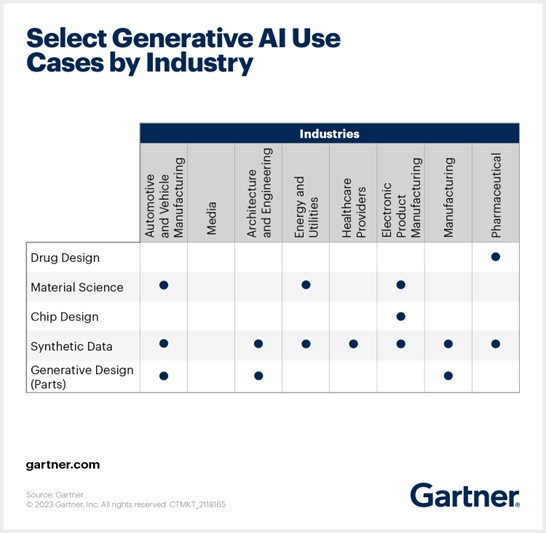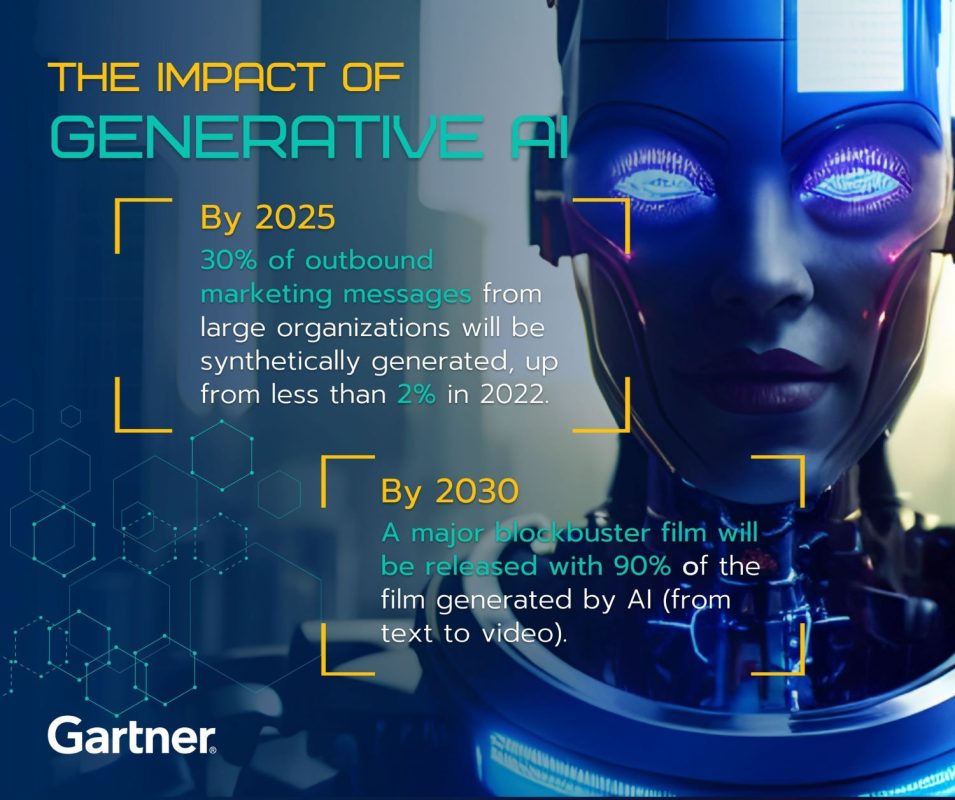By Brian Burke, Research VP for Technology Innovation at Gartner
ChatGPT, while cool, is just the beginning; enterprise uses for generative AI are far more sophisticated.
Venture capital firms have invested over US$1.7 billion in generative AI solutions over the last three years, with AI-enabled drug discovery and AI software coding receiving the most funding.
Early foundation models like ChatGPT focus on the ability of generative AI to augment creative work, but we expect more than 30% of new drugs and materials to be systematically discovered using generative AI techniques by 2025 – up from zero today. And that is just one of numerous industry use cases.
Uses cases for generative AI
Generative AI can explore many possible designs of an object to find the right or most suitable match. It not only augments and accelerates design in many fields, it also has the potential to “invent” novel designs or objects that humans may have missed otherwise.
Marketing and media are already feeling the impacts of generative AI. Gartner predicts that 30% of outbound marketing messages from large organizations will be synthetically generated by 2025, up from less than 2% in 2022. In addition, a major blockbuster film will be released by 2030 with 90% of the film generated by AI (from text to video).
Still, AI innovations are generally accelerating, creating numerous use cases for generative AI in various industries.
1. Drug Design
Generative AI has already been used to design drugs for various uses within months, rather than years, offering pharma significant opportunities to reduce both the costs and timeline of drug discovery.
2. Material Science
Generative AI is impacting the automotive, aerospace, defense, medical, electronics and energy industries by composing entirely new materials targeting specific physical properties.
The process, called inverse design, defines the required properties and discovers materials likely to have those properties rather than relying on serendipity to find a material that possesses them. The result is to find, for example, materials that are more conductive or greater magnetic attraction than those currently used in energy and transportation — or for use cases where materials need to be resistant to corrosion.
3. Chip Design
Generative AI can use reinforcement learning (a machine learning technique) to optimize component placement in semiconductor chip design (floorplanning), reducing product-development life cycle time from weeks with human experts to hours with generative AI.
4. Synthetic data
Generative AI is one way of creating synthetic data, a class of data that is generated rather than obtained from direct observations of the real world. This ensures the privacy of the original sources of the data that was used to train the model. For example, healthcare data can be artificially generated for research and analysis without revealing the identity of patients whose medical records were used to ensure privacy.
5. Parts design
Generative AI enables industries, including manufacturing, automotive, aerospace and defense, to design parts that are optimized to meet specific goals and constraints, such as performance, materials and manufacturing methods. Automakers, for example, can use generative design to innovate lighter designs — contributing to their goals of making cars more fuel efficient.
Embedding the right technologies
Most AI systems today are classifiers, meaning they can be trained to distinguish between images of dogs and cats. Generative AI systems can be trained to generate an image of a dog or a cat that doesn’t exist in the real world. The ability for technology to be creative is a game changer.
Generative AI enables systems to create high-value artifacts, such as video, narrative, training data and even designs and schematics.
Generative Pre-trained Transformer (GPT), for example, is the large-scale natural language technology that uses deep learning to produce human-like text. The third generation (GPT-3), which predicts the most likely next word in a sentence based on its absorbed accumulated training, can write stories, songs and poetry, and even computer code — and enables ChatGPT to do your teenager’s homework in seconds.
Beyond text, digital-image generators, such as DALL-E 2, Stable Diffusion and Midjourney, can generate images from text.
Don’t forget the risks
Before you forge full-speed ahead, remember that generative AI doesn’t just present opportunities for business, the threats are real too. Some examples include the potential for deepfakes, copyright issues and other malicious uses of generative AI technology to target your organization.
Work with security and risk management leaders to proactively mitigate the reputational, counterfeit, fraud and political risks that malicious uses of generative AI present to individuals, organizations and governments.
Also consider implementing guidance on the responsible use of generative AI through a curated list of approved vendors and services, prioritizing those that strive to provide transparency on training datasets and appropriate model usage, and/or offer their models in open source.
About Gartner
Gartner, Inc. (NYSE: IT) delivers actionable, objective insight to executives and their teams. Our expert guidance and tools enable faster, smarter decisions and stronger performance on an organization’s mission critical priorities. To learn more, visit gartner.com.
Source: PC & Associates Consulting

